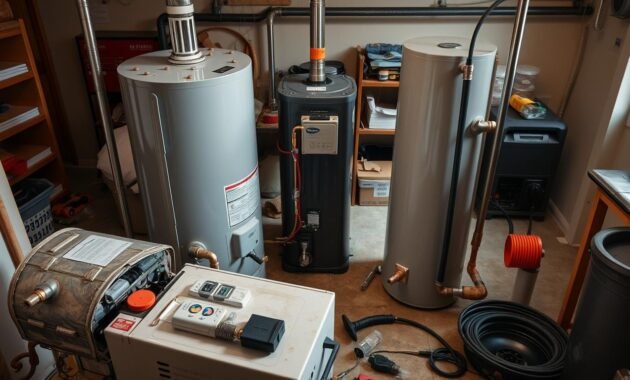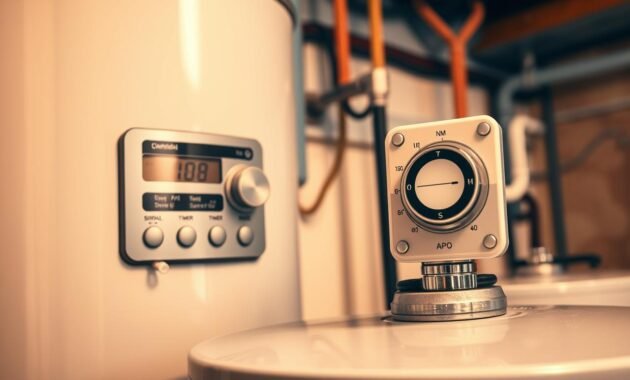Are you fed up with high energy bills and safety worries with your gas water heater? Many homeowners face the same issues. Their water heating systems are often inefficient, outdated, and expensive.
Switching to an electric water heater is a smart move. It can make your home more energy-efficient, cut down on environmental harm, and ensure safer, more reliable hot water. Let’s explore how to make this change.

Understanding the Benefits of Converting from Gas to Electric Water Heating
Thinking about upgrading your home? Switching to an electric water heater is a smart move. It brings many benefits like better efficiency, less harm to the environment, and more safety.
Today’s electric water heaters are a game-changer for your home’s energy use. A conversion kit can change how your home uses energy. It offers many advantages beyond just hot water.
Energy Efficiency Improvements
Electric water heaters, like heat pump models, use a lot less energy. This means lower bills and less energy use for you.
- Up to 60% more energy-efficient than standard gas models
- Lower operational costs
- Consistent water heating performance
Environmental Impact Reduction
Choosing electric reduces your carbon footprint. Electric water heaters don’t emit direct emissions, helping the environment.
| Energy Source | Carbon Emissions | Environmental Impact |
|---|---|---|
| Gas Water Heater | High | Significant greenhouse gases |
| Electric Water Heater | Low | Minimal direct emissions |
Safety Advantages of Electric Systems
Electric water heaters are safer than gas ones. They don’t risk gas leaks or carbon monoxide poisoning. Plus, many companies offer rebates to help you switch.
- No combustion risks
- No gas leak possible
- Safer for families with kids and pets
Choosing a gas to electric conversion kit is a wise choice. It’s not just an upgrade—it’s a step towards a greener, safer home.
Cost Analysis: Initial Investment vs Long-term Savings
Homeowners often worry about the cost of switching to an electric water heater. The initial cost might seem high. But, the long-term savings are worth it.
The initial costs include several key areas:
- Electric water heater unit: $500 – $1,500
- Installation fees: $300 – $800
- Electrical system modifications: $200 – $500
- Permit and inspection costs: $100 – $250
Even with these costs, you can save a lot in the long run. Modern electric water heaters use less energy, which means lower bills. Most homeowners can pay back their initial investment in 3-5 years.
Utility companies often give rebates for switching to electric. These rebates can cover up to 30% of the costs. It’s a good idea to check with your local energy providers for available programs.
To save even more, consider these tips:
- Choose an Energy Star certified electric water heater
- Install during off-peak energy hours
- Implement additional home energy efficiency upgrades
Switching to an electric water heater is more than just saving money. It’s also good for your home’s future and the environment.
Essential Tools and Materials for Gas to Electric Conversion
Switching from a gas to an electric water heater needs careful planning and the right tools. I’ll show you what you need for a smooth conversion.
Before you start, make sure you have all the tools and parts. This will help you do the job well and quickly.
Required Electrical Components
- 220-240V electric water heater
- Electrical conduit and wiring
- Circuit breaker (30-50 amp)
- Electrical junction box
- Disconnect switch
Safety Equipment Checklist
- Protective safety glasses
- Insulated electrical gloves
- Non-conductive work boots
- Voltage tester
- Fire extinguisher
Installation Tools Needed
| Tool Category | Specific Tools |
|---|---|
| Electrical Tools | Wire strippers, electrical tape, multimeter |
| Plumbing Tools | Pipe wrenches, pipe cutters, Teflon tape |
| Mounting Tools | Level, drill, mounting brackets |
Having these tools ready will make your gas to electric water heater switch easier. It ensures a safe and efficient setup.
How to Convert Gas Water Heater to Electric: Step-by-Step Process

Upgrading to an electric water heater from a gas one needs careful planning. I’ll show you the key steps for a smooth changeover in your home’s water heating system.
First, get all the tools and safety gear ready. The conversion involves several important steps. Each one needs attention to detail and safety rules.
- Shut off the gas supply completely
- Disconnect and drain the existing gas water heater
- Remove the old gas unit from its current location
- Prepare the installation area for the new electric water heater
- Position the new electric water heater
- Connect water supply lines
- Install electrical connections
- Test the new electric water heating system
Every step in converting your water heater is critical. Make sure to measure your space well. Also, check if your home’s electrical system can handle the new heater.
For the electrical connections, getting help from a pro is wise. Switching to electric involves complex electrical work. A licensed electrician is needed to ensure it’s done safely and right.
Remember, safety is key. Check the electrical circuit’s capacity, voltage, and local building codes. Always put safety first in this big home improvement project.
Electrical Requirements and Circuit Installation
Switching to an electric water heater? Knowing the electrical needs is key for a safe setup. Your home’s electrical system is important for the new heater’s performance. Proper preparation is essential.
Replacing a gas water heater with an electric one needs careful electrical checks. Most electric water heaters need a 240-volt circuit with specific amperage.
Voltage and Amperage Specifications
Electric water heaters need a strong electrical setup. Here are the main electrical needs:
- Standard voltage requirement: 240 volts
- Typical amperage range: 30-50 amps
- Dedicated circuit recommendation
- Professional electrical assessment recommended
Circuit Breaker Installation Guidelines
Choosing the right circuit breaker is vital for your electric water heater. Here’s what you need to know:
| Water Heater Size | Recommended Breaker | Typical Amperage |
|---|---|---|
| 40-50 Gallon | Double-pole | 30-40 amps |
| 60-80 Gallon | Double-pole | 50 amps |
It’s wise to get a licensed electrician for circuit installation. They can check your home’s electrical system. They’ll make sure it’s ready for the new electric water heater.
Safety Considerations During Conversion
When I’m working on an electric water heater installation after removing gas, safety is my main focus. The conversion process has many important safety steps. These steps keep you and your home safe from harm.
Electrical safety is key during the installation. Here are some steps to take:
- Shut off all power sources before starting
- Wear the right personal protective equipment (PPE)
- Check electrical connections before turning on power
- Make sure the circuit fits the new water heater
Removing the gas line needs special knowledge to avoid dangers. A pro can check if it’s done right and sealed well. Good ventilation is also important to keep the area safe while installing.
Here are more safety steps to follow:
- Check local building codes
- Get the right permits
- Inspect all equipment carefully
- Make sure there’s proper electrical grounding
I always suggest getting a licensed pro for this job. They know how to do it safely and right, following all rules.
Proper Gas Line Disconnection and Capping Procedures
Converting a gas water heater to electric starts with safely disconnecting the gas line. I’ll show you how to do it right, ensuring a safe and professional job.
Before you start, take important safety steps. Shutting down the gas supply needs careful attention and precise steps.
Gas Supply Shutdown Protocol
To start the conversion, follow these key steps:
- Find the main gas shutoff valve for your home
- Turn the valve all the way off to stop gas flow
- Check if gas flow is stopped with a gas detector
- Remove the gas line from the water heater
Professional Inspection Requirements
While some try DIY, I advise hiring a licensed pro for gas line disconnection. A certified technician can:
- Correctly cap the gas line
- Make sure there are no gas leaks
- Give a safety check for your home
- Confirm the gas line is fully decommissioned
Getting a professional inspection is key for your home’s safety during the conversion. They use special tools to find any gas left and seal the line right.
By following these steps, you’ll safely disconnect the gas line. Then, you’re ready for installing a new electric water heater.
Timer Installation and Programming Options

When you switch to an electric water heater, adding a timer can make a big difference. These smart devices let you control when your water heater runs. This cuts down on energy waste.
Think about what timer fits your home’s hot water needs. Today’s digital timers come with cool features for saving energy:
- Customizable scheduling for peak and off-peak hours
- Programmable daily and weekly heating cycles
- Energy consumption tracking features
- Remote smartphone app connectivity
Choosing the right timer means knowing what you need for your electric water heater. Most timers work with 240-volt heaters and are easy to install near your electrical panel.
| Timer Type | Programming Flexibility | Cost Range |
|---|---|---|
| Mechanical Dial Timer | Basic on/off scheduling | $25-$50 |
| Digital Programmable Timer | Advanced multi-day scheduling | $75-$150 |
| Smart WiFi Timer | App-controlled, real-time monitoring | $100-$250 |
Adding a timer to your electric water heater can save you money and get you rebates. It’s a smart move for your wallet and the planet.
Maintenance Tips for Your New Electric Water Heater
After switching to an electric water heater, keeping it in good shape is key. Regular care stops unexpected problems and keeps your system running well. This helps your new electric water heater last longer.
Keeping your electric water heater in top shape is easy. I’ll show you simple steps to keep it working right.
Creating a Regular Inspection Schedule
Regular checks are important to protect your investment. Here are key things to check:
- Check pressure relief valve every six months
- Inspect electrical connections quarterly
- Flush tank annually to remove sediment buildup
- Test water temperature and pressure settings
Troubleshooting Common Issues
Even with an electric water heater, issues can pop up. Knowing how to fix them saves time and money:
- No hot water: Check circuit breaker and heating elements
- Unusual noises: Possible sediment buildup needing a tank flush
- Water leaks: Look at connections and pressure relief valve
- Inconsistent water temperature: Check thermostat settings
By following these tips, you’ll get the most out of your electric water heater. It will provide hot water reliably for many years.
Permits and Professional Requirements
Converting a gas water heater to electric requires understanding local permits and professional needs. Each area has its own rules for water heater changes.
Building codes often demand a pro for gas to electric swaps. Important points include:
- Getting the right permits before starting
- Booking inspections with local building officials
- Ensuring electrical work is up to date
- Checking if the work fits local plumbing and electrical rules
It’s wise to talk to your local building office about what’s needed for electric water heater swaps. Most places need:
| Requirement | Details |
|---|---|
| Electrical Permit | Mandatory for new circuit installation |
| Plumbing Permit | Required for water line changes |
| Professional Certification | Licensed electrician or plumber advised |
Choosing a licensed pro ensures your swap is safe and legal. While DIY might appeal, a pro’s job is to disconnect gas lines right, make electrical connections correctly, and follow local codes.
Conclusion
Switching to an electric water heater is a smart choice for homeowners. It improves energy efficiency and safety. My research shows many good reasons to make this change.
Going electric is more than just swapping out your old heater. It’s about making your home better for the planet and more modern. Electric water heaters save money, are safer, and use cleaner energy.
Before you start, think about what you need for your home. Getting help from a pro is key for a smooth switch. Even though it might seem hard, the benefits of electric heating are worth it.
Starting your journey to a greener home is easy. Just think about the costs, savings, and how it helps the environment. This will help you make a choice that’s good for your home and the planet.


